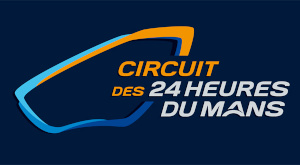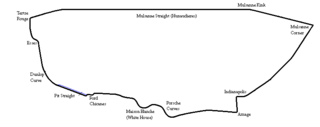
The V6 PRV engine is an automobile petrol V6 engine that was developed jointly by Peugeot, Renault and Volvo Cars – and sold from 1974 to 1998. It was gradually replaced after 1994 by another joint PSA-Renault design, known as the ES engine at PSA and the L engine at Renault. It was designed and manufactured by the company "Française de Mécanique" for PSA, Renault and Volvo.

The 24 Hours of Le Mans is an endurance-focused sports car race held annually near the town of Le Mans, France. It is widely considered to be one of the world's most prestigious races, and is one of the races—along with the Monaco Grand Prix and Indianapolis 500—that form the Triple Crown of Motorsport, and is also one of the races alongside the 24 Hours of Daytona and 12 Hours of Sebring that make up the informal Triple Crown of endurance racing. Run since 1923, it is the oldest active endurance racing event in the world.

The Circuit des 24 Heures du Mans, also known as Circuit de la Sarthe located in Le Mans, Sarthe, France, is a semi-permanent motorsport race course, chiefly known as the venue for the 24 Hours of Le Mans auto race. Comprising private, race-specific sections of track in addition to public roads which remain accessible most of the year, its present configuration is 13.626 km (8.467 mi) long, making it one of the longest circuits in the world. The capacity of the race stadium, where the short Bugatti Circuit is situated, is 100,000. The Musée des 24 Heures du Mans is a motorsport museum located at the main entrance of the venue.

The 1997 24 Hours of Le Mans was the 65th Grand Prix of Endurance, and took place on 14 and 15 June 1997.

The 1994 24 Hours of Le Mans was the 62nd Grand Prix of Endurance, and took place on 18 and 19 June 1994.

The 1993 24 Hours of Le Mans was the 61st Grand Prix of Endurance, and took place on 19 and 20 June 1993.

The 1989 24 Hours of Le Mans was the 57th Grand Prix of Endurance, taking place at the Circuit de la Sarthe, France, on the 10 and 11 June 1989. This year it was not included as a round of the 1989 World Sports-Prototype Championship. The entry list promised a strong contest between five manufacturers. Jaguar had won in 1988 and went on to win the championship; while Sauber had finished second and was now matching Jaguar on the track. New regulations were coming in 1991, and the first examples of the 3.5-litre normally-aspirated formula were entered by Spice Engineering.

The 1988 24 Hours of Le Mans was the 56th Grand Prix of Endurance as well as the fifth round of the 1988 World Sports-Prototype Championship. It took place at the Circuit de la Sarthe, France, on the 11 and 12 June 1988. At their third attempt, Jaguar arrived with five cars to take on the strong Porsche works team of three cars, in their only race for the Championship season. The other potential rival was Sauber, now formally backed by Mercedes-Benz, but after a major high-speed tyre-blowout in practice, their two-car team was withdrawn.

The 1987 24 Hours of Le Mans was the 55th Grand Prix of Endurance as well as the fifth round of the 1987 World Sports-Prototype Championship. It took place at the Circuit de la Sarthe, France, on the 13 and 14 June 1987. Jaguar was a strong contender, have won the four preceding rounds of the Championship. The Porsche works team had installed a new 3-litre engine into their 962s but their turbo engines would test their fuel economy.

The 1982 24 Hours of Le Mans was the 50th Grand Prix of Endurance, which took place on 19 and 20 June 1982. It was also the fourth round of the 1982 World Endurance Championship. As well as a significant anniversary, this was a watershed year for Le Mans, with the highly anticipated advent of the FIA's Group C regulations, the essence of which was to allow an open engine formula but a minimum weight for safety and a proscribed fuel allocation.

The 1980 24 Hours of Le Mans was the 48th Grand Prix of Endurance, and took place on 14 and 15 June 1980. It was the seventh round of both the World Championship for Makes and World Challenge for Endurance Drivers. With neither the Porsche nor Renault works teams contesting the big Group 6 sports-cars for outright victory, it left the prospects open for a privateer victory from Joest, Rondeau or De Cadenet, or from Group 5 again, if they were to fail. The wet weather throughout the race further added to the uncertainty, reducing the advantage of the more powerful cars.

The 1976 24 Hours of Le Mans was the 44th Grand Prix of Endurance, and took place on 12 and 13 June 1976. This year the FIA introduced its new Group 5 and Group 6 regulations and the race was now open to nine distinct classes, although it was still not part of the World Championship seasons. Porsche introduced its new models, the 936 in Group 6, the 935 in Group 5 and the 934 in Group 4. In response, BMW had its modified 3.0 CSL in Group 5. It was the year that turbos arrived in considerable numbers, with over a dozen turbocharged entries, led by the Renault Alpine A442. It saw the arrival of French prototype manufacturers Jean Rondeau and Gérard Welter in a new GTP class and a first-time invitation to American IMSA and NASCAR entries.

Welter Racing is a French sports car maker that mainly enters in the 24 Hours of Le Mans, since 1990 under the name of Rachel and Gérard Welter, Peugeot's late head of design or Rachel Welter.

The 75th 24 Hours of Le Mans was a 24-hour automobile endurance race for Le Mans Prototype and Grand Touring cars, which took place at the Circuit de la Sarthe, near Le Mans, France, from 16 to 17 June 2007. It was the 75th edition of the event, as organised by the automotive group, the Automobile Club de l'Ouest (ACO) since 1923. Unlike other events, it was not a part of any endurance motor racing championship. A test day was held two weeks prior to the race on 3 June. The event was attended by 250,952 spectators.

The 2008 24 Hours of Le Mans was the 76th Grand Prix of Endurance, taking place on 14–15 June 2008 at the Circuit de la Sarthe, Le Mans, France, organised by the Automobile Club de l'Ouest (ACO). The test day was on June 1. The race was attended by 258,000 spectators. The Audi team's progress and victory was documented in the 2008 film Truth in 24.

The Mulsanne Straight is the name used in English for a formerly 6 km (3.7 mi) long straight of the Circuit de la Sarthe around which the 24 Hours of Le Mans auto race takes place. Since 1990, the straight is interrupted by two chicanes, with the last section leading to a sharp corner near the village of Mulsanne. Before the chicanes were added, the Mulsanne Straight was the longest straight section of any race track in the world.

The 2009 24 Hours of Le Mans was the 77th Grand Prix of Endurance, an endurance auto race run over 24 hours. It took place at the Circuit de la Sarthe, Le Mans, France, and was organised by the Automobile Club de l'Ouest (ACO) over 13–14 June 2009 and was started by Fiat and Ferrari chairman Luca Cordero di Montezemolo at 15:00 local time. A test day was initially scheduled for 31 May that year, but was canceled by the ACO due to economic concerns. The race was attended by 234,800 spectators.

The Welter-Meunier P80 is a sports prototype race car, designed, developed and built by French racing team Welter Racing, for sports car racing, specifically the 24 Hours of Le Mans, between 1980 and 1982. It was powered by a twin-turbocharged 2.7 L (160 cu in) Peugeot PRV V6 engine, producing 500 hp (370 kW), which drove the rear wheels through a 5-speed ZF manual transmission. The bodywork is constructed out of Kevlar epoxy and carbon fiber.
The Welter-Meunier P82, and its successors and derivatives, including the P83, the P83B, and the P86, are a series of mid-engined Group C sports prototype race cars, designed, developed and built by French racing team Welter Racing, for sports car racing, between 1982 and 1986. The cars best result was a 6th-place finish at the 1982 1000km of Monza, being driven by Roger Dorchy, Guy Fréquelin, and Jean-Daniel Raulet. It was powered by a Garrett twin-turbocharged, 2.7 L (160 cu in), Peugeot PRV, V6 engine, producing between 600–890 hp (450–660 kW) @ 8300 rpm, depending on boost pressure, which drove the rear wheels through a 5-speed manual transmission. The chassis design was constructed into an aluminum monocoque, and the car weighed approximately 900 kg (2,000 lb).

The Welter-Meunier P88 is a Group C sports prototype race car, designed, developed, and built by the French racing team Welter Racing, specifically to compete in the 24 Hours of Le Mans that year. It was designed and constructed according to the FIA's technical and sporting regulations for sports car racing.













